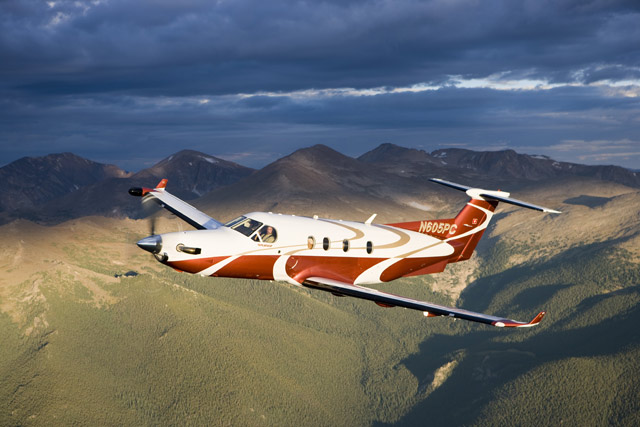Quick Look: Pilatus PC–12
Bold design burst upon the scene in 1995 and hasn’t looked back

Twenty years ago, a not so widely known Swiss manufacturer burst upon the scene with a turboprop single that specifically targeted the Beechcraft King Air 200, which had been the 800-pound gorilla of the turboprop market. Pilatus’ PC–12 offered a similar-size cabin with a more fuel efficient and simple-to-fly option to the traditional twins. At the time, single-engine turboprops couldn’t be used in Part 135 charter operations, making the PC–12 a huge gamble for Pilatus. Was the gamble worth it?
A resounding “yes” would be the answer. Part 135 operations with single-engine turbines later were approved and PC–12s have been a sales success. The PC–12 offers speed within 20 knots of the King Air 200 while burning about 450 pounds per hour of Jet-A, which is about 300 pounds per hour less than the mighty 200. And unlike the Beechcraft, the PC–12 features a massive rear door that can swallow cargo as large as an ATV or personal watercraft.
The Pilatus is ruggedly built and is just as at home on a grass runway as it would be on the ramp at the busiest airline hub. In fact, the PC–12’s 67-knot stall speed means it can utilize most runways that light trainers use. Just make sure the airport can accommodate its 53-foot wingspan.
On the nose of early PC–12s is a Pratt & Whitney PT6A-67B that is flat rated to 1,200 shaft horsepower. With all the power in one engine, there are none of the complex handling characteristics of engine-out operations that make the traditional twins a bear to handle when an engine fails. But naturally, just like a light single-engine trainer, if that engine quits you’re flying a glider. If it happens at high altitude, however the PC–12 can glide as many as 80 nm in a no-wind situation.
Up front, the PC–12 has a logical cockpit layout with color-coded circuit breakers to delineate the many systems. Early PC–12 avionics are Bendix-King ED462 EADI and EHSI screens backed up with a Bendix-King KLN 90B GPS navigator (remember those?). A Bendix-King RDR 82VP radar was also available. Master warning and caution lights warn of system malfunctions, just like in modern jets.
In 2008, the Next Generation PC–12 arrived with a more powerful PT6-67P, which holds power to a higher altitude, increasing cruise speed by about 10 knots. Models are broken down by max takeoff weight in kilograms. The -41 model has a takeoff weight of 4,100 kg (9,039 pounds). There are also -45 and -47 models with corresponding takeoff weights of 9,921 and 10,450 pounds, respectively. The -41 can be upgraded to -45 status by service bulletin.
PC–12s have heavy controls. Ailerons were modified in 2006 with servo tabs to lighten the loads on the pilot flying. Large, effective flaps make 80-knot approaches possible and a beefy trailing-link landing gear allow for smooth landings.
While the PT6 engine failure rate is statistically low, there is always a chance of failure and there are those owners for whom nothing less than two engines will do. For the rest, the PC–12 fits the bill quite nicely.
Pete Bedell is a pilot for a major airline and co-owner of a Cessna 172 and Beechcraft Baron D55.
SPEC SHEET
Pilatus PC–12
Vref value 1995 Model PC-12 $1.55 million
2014 PC–12NG $4.5 million
Powerplant | 1,200-shp Pratt & Whitney PT6A-67B
Length | 46 ft 9 in
Height | 13 ft 10 in
Wingspan | 52 ft 9 in
Seats | 2+7-9
Max takeoff weight | 9,039-10,450 lb
Takeoff distance over 50-ft obstacle | 1,821 ft
Max cruise speed | 269 kt
Landing distance over 50-ft obstacle | 1,837 ft
Range | 2,000 nm
Photo by Mike Fizer


